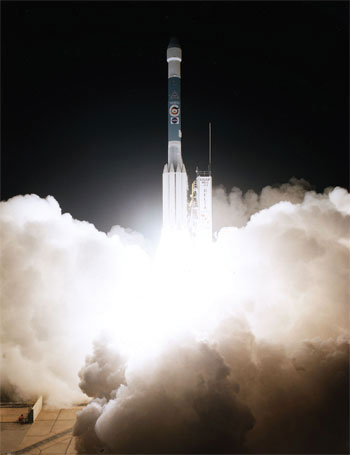
On the evening of July 4, 1997, Jacob Matijevic (MATH ’69) waited along with the rest of the world for the Mars rover called Sojourner to exit the Pathfinder lander and begin its exploration of the red planet. This new era of U.S. space exploration was, for Matijevic, not only an historic event, but also a critical moment in his career—a culmination of decades of work and study. Matijevic remembers, “It was a hectic two days of commanding the rover to drive down Pathfinder’s ramp. By approximately midnight PDT on July 5, we received confirming images that the rover was on Mars.” It had been a long ride, but Matijevic and Sojourner had finally arrived.
“That was one of the happiest days of my life,” says Matijevic. “It was a fitting end to nearly five years of struggle to develop, test, and operate this new space system and a great reward for the efforts of a team of dedicated engineers.”

Photo courtesy NASA/JPL
Matijevic had become intrigued with the National Aeronautics and Space Administration (NASA) space program, specifically the Voyager missions, while teaching mathematics at the University of Southern California. Twin Voyagers 1 and 2, which launched in 1977, began an extensive tour of the outer solar system by visiting Jupiter and Saturn before being propelled further. Still sending signals back to Earth, they remain the farthest human-created objects to travel from Earth and are on target to be the first spacecraft to leave the confines of our heliosphere—an immense magnetic bubble containing our solar system, solar wind, and the entire solar magnetic field. Matijevic followed Voyager’s discoveries closely, and in 1981 his interest led him to NASA’s Jet Propulsion Laboratories (JPL), where he currently works in operations as the Mars Exploration Rover Engineering Team chief.
Over the course of its existence, NASA has pursued new ways to increase the level of detail gleaned from its planetary missions. The rover has extended the capacity of knowledge gained from unmanned explorations. ‘Rover’ is a general term used to describe a thinking robot on wheels with cameras that serve as its eyes. They travel inside landers, spacecraft that land on the surface of another planet and are capable of collecting data, but that remain stationary after landing. Rovers are programmed to run on autopilot and to react to unexpected activity or planetary terrain. Information obtained by the rover is transmitted to the lander, which stores and sends messages in between the rover and a NASA operator.
Matijevic says that while design concepts for rovers can be prototyped relatively easily, it is only through rigid testing of these prototypes that engineers are able to identify problems prior to implementation.
“Testing the capability of these vehicles to engage and then drive over obstacles illustrates the geometric and dynamic limitations of the rover’s design,” he says. “When possible, I like to include testing in a variety of terrains. There are many situations presented to a vehicle in these tests that cannot be fully replicated in a sandbox.”
Matijevic began working with robotics at JPL following the missions of NASA’s Viking 1 and 2, which were the first successful landers to study Mars, in 1976 and 1982. After years of working on advanced mission concepts and technology development, Matijevic joined the first flight demonstrator project and helped to create Sojourner. Sojourner weighed only 23 pounds and explored about 750 square feet of Martian surface, collecting 16,500 images from the lander’s camera. Today, Sojourner is still on the surface of Mars waiting to be retrieved. Opportunity and Spirit followed, deployed in January 2004. The rovers continue to send back exciting new details about Mars; as of press date, Spirit had driven 3.07 miles and Opportunity 3.65 miles.
In August 2005, NASA launched its most recent exploratory effort, the Mars Reconnaissance Orbiter. The craft is on schedule to arrive in the Martian orbit in March 2006, when it will use cameras to take extreme close-up photography of the Martian surface, carry a sounder to find subsurface water, and look for safe and scientifically worthy sites for future rover exploration.
With new glimpses of Mars and prospective missions to the planet shaping his day-to-day life, Matijevic sees the galaxy through a lens into which the rest of us could only hope to view. Still, he says, one discovery would trump them all: “Hopefully these future missions will discover evidence that can determine whether there had been past life on Mars. That’s the one space exploration achievement I’d like to see in my lifetime.’
The Robot Hall of Fame

Almost a decade after its historic trip on the surface of Mars, Sojourner received national recognition, along with three other robots, when they were all welcomed into the Robot Hall of Fame. At Carnegie Hall on November 10, 2003, the First Annual Induction Ceremony honored the Mars Pathfinder Sojourner Rover; the first industrial robot, Unimate, developed in 1961, which worked with heated die-casting machines on the assembly line at a General Motors plant; and two movie stars: R2-D2 of Star Wars and HAL 9000, a central character in the Stanley Kubrick and Arthur C. Clarke classic, 2001: A Space Odyssey.
A Hole in One
Sojourner began its journey on Pathfinder seven months prior to its Mars landing- traveling 119 million miles from Earth to its destiny. Moments before reaching the surface, Pathfinder released its air bags in preparation for impact. Around NASA, it has been said that the accomplishment of landing the Pathfinder was like playing a par-four hole of golf, teeing off in California and aiming for a four-inch, moving hole in Texas. According to the space mission log, the rover’s primary goals were scheduled to occur within the first seven ‘Martian days’ and all within about 30 feet of the lander. The extended mission included additional analyses of nearby rock and soil and more tests of the rover’s capabilities.